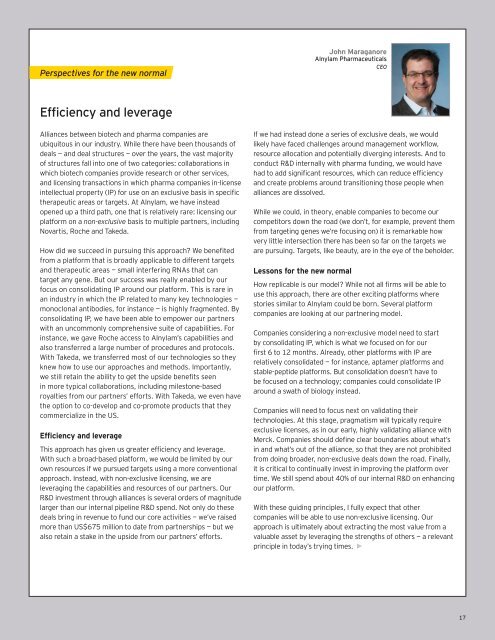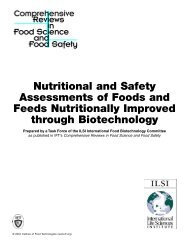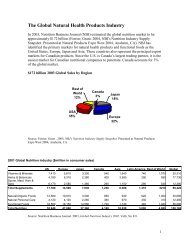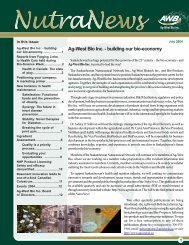Beyond Borders: Global biotechnology report 2010
Beyond Borders: Global biotechnology report 2010
Beyond Borders: Global biotechnology report 2010
You also want an ePaper? Increase the reach of your titles
YUMPU automatically turns print PDFs into web optimized ePapers that Google loves.
Perspectives for the new normal<br />
Efficiency and leverage<br />
Alliances between biotech and pharma companies are<br />
ubiquitous in our industry. While there have been thousands of<br />
deals — and deal structures — over the years, the vast majority<br />
of structures fall into one of two categories: collaborations in<br />
which biotech companies provide research or other services,<br />
and licensing transactions in which pharma companies in-license<br />
intellectual property (IP) for use on an exclusive basis in speci c<br />
therapeutic areas or targets. At Alnylam, we have instead<br />
opened up a third path, one that is relatively rare: licensing our<br />
platform on a non-exclusive basis to multiple partners, including<br />
Novartis, Roche and Takeda.<br />
How did we succeed in pursuing this approach? We bene ted<br />
from a platform that is broadly applicable to different targets<br />
and therapeutic areas — small interfering RNAs that can<br />
target any gene. But our success was really enabled by our<br />
focus on consolidating IP around our platform. This is rare in<br />
an industry in which the IP related to many key technologies —<br />
monoclonal antibodies, for instance — is highly fragmented. By<br />
consolidating IP, we have been able to empower our partners<br />
with an uncommonly comprehensive suite of capabilities. For<br />
instance, we gave Roche access to Alnylam’s capabilities and<br />
also transferred a large number of procedures and protocols.<br />
With Takeda, we transferred most of our technologies so they<br />
knew how to use our approaches and methods. Importantly,<br />
we still retain the ability to get the upside bene ts seen<br />
in more typical collaborations, including milestone-based<br />
royalties from our partners’ efforts. With Takeda, we even have<br />
the option to co-develop and co-promote products that they<br />
commercialize in the US.<br />
Efficiency and leverage<br />
This approach has given us greater ef ciency and leverage.<br />
With such a broad-based platform, we would be limited by our<br />
own resources if we pursued targets using a more conventional<br />
approach. Instead, with non-exclusive licensing, we are<br />
leveraging the capabilities and resources of our partners. Our<br />
R&D investment through alliances is several orders of magnitude<br />
larger than our internal pipeline R&D spend. Not only do these<br />
deals bring in revenue to fund our core activities — we’ve raised<br />
more than US$675 million to date from partnerships — but we<br />
also retain a stake in the upside from our partners’ efforts.<br />
John Maraganore<br />
Alnylam Pharmaceuticals<br />
CEO<br />
If we had instead done a series of exclusive deals, we would<br />
likely have faced challenges around management work ow,<br />
resource allocation and potentially diverging interests. And to<br />
conduct R&D internally with pharma funding, we would have<br />
had to add signi cant resources, which can reduce ef ciency<br />
and create problems around transitioning those people when<br />
alliances are dissolved.<br />
While we could, in theory, enable companies to become our<br />
competitors down the road (we don’t, for example, prevent them<br />
from targeting genes we’re focusing on) it is remarkable how<br />
very little intersection there has been so far on the targets we<br />
are pursuing. Targets, like beauty, are in the eye of the beholder.<br />
Lessons for the new normal<br />
How replicable is our model? While not all rms will be able to<br />
use this approach, there are other exciting platforms where<br />
stories similar to Alnylam could be born. Several platform<br />
companies are looking at our partnering model.<br />
Companies considering a non-exclusive model need to start<br />
by consolidating IP, which is what we focused on for our<br />
rst 6 to 12 months. Already, other platforms with IP are<br />
relatively consolidated — for instance, aptamer platforms and<br />
stable-peptide platforms. But consolidation doesn’t have to<br />
be focused on a technology; companies could consolidate IP<br />
around a swath of biology instead.<br />
Companies will need to focus next on validating their<br />
technologies. At this stage, pragmatism will typically require<br />
exclusive licenses, as in our early, highly validating alliance with<br />
Merck. Companies should de ne clear boundaries about what’s<br />
in and what’s out of the alliance, so that they are not prohibited<br />
from doing broader, non-exclusive deals down the road. Finally,<br />
it is critical to continually invest in improving the platform over<br />
time. We still spend about 40% of our internal R&D on enhancing<br />
our platform.<br />
With these guiding principles, I fully expect that other<br />
companies will be able to use non-exclusive licensing. Our<br />
approach is ultimately about extracting the most value from a<br />
valuable asset by leveraging the strengths of others — a relevant<br />
principle in today’s trying times.<br />
17








